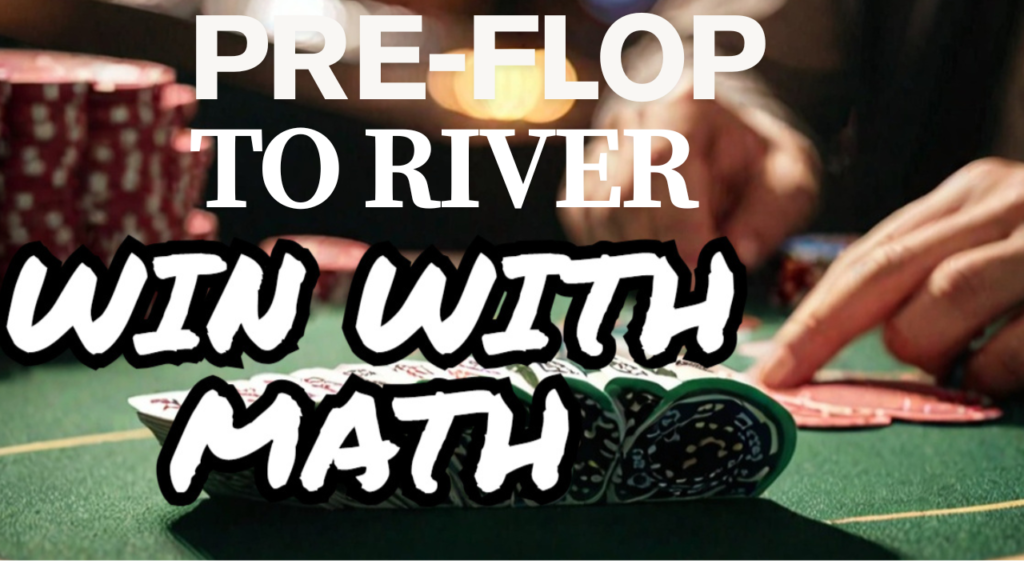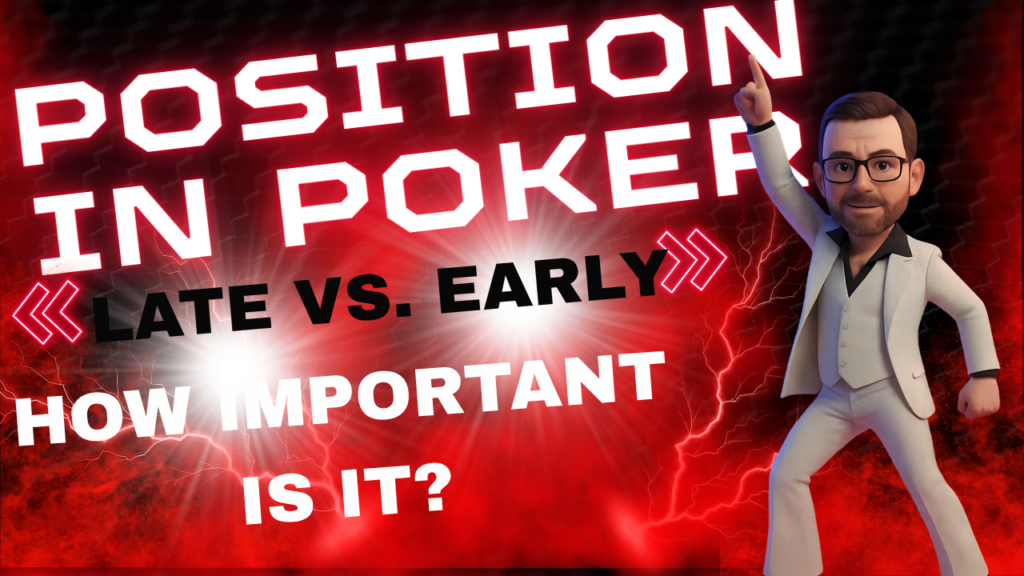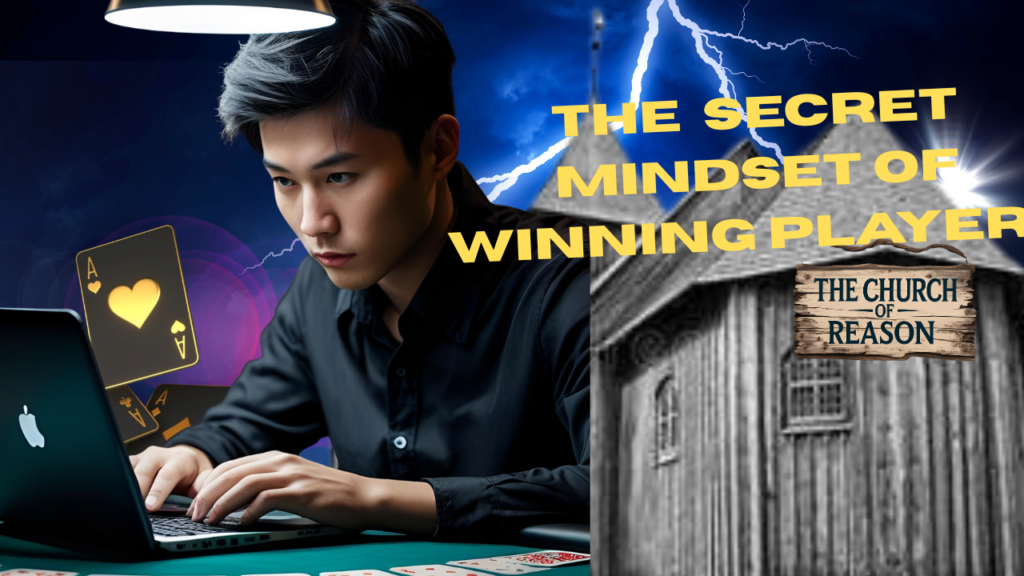WHY YOU KEEP MAKING THE SAME POKER MISTAKES
AND HOW TO BREAK THE CYCLE
Avoiding common poker mistakes is one of the great dividing lines between the player who breaks even and the one who consistently builds a bankroll. But the most costly errors aren’t buried in obscure spots—they’re right on the surface. In fact, the three biggest mistakes in poker are painfully familiar to most players:
- Playing too many hands
- Overvaluing your hand strength
- Taking hands too far
These aren’t just common—they’re interconnected. One leads to another. You play a weak hand because you’re bored. You hit middle pair and convince yourself it’s good. Then you call again on the turn, hoping something will change. Most players don’t just make one of these mistakes—they make all three, over and over again.
So why does this happen?
That’s what this article is here to uncover. We’re going to explore the real roots of common poker mistakes: boredom, ego, lack of focus, impatience, faulty logic, and the refusal to study the one thing most players avoid—the math, the underlying form of poker.
We’ll examine how one poor decision can cascade into long-term consequences: lost money, emotional tilt, fractured table image, and even a breakdown in confidence. And we’ll show how common errors are not isolated events but reflections of deeper blind spots—psychological, strategic, and philosophical.
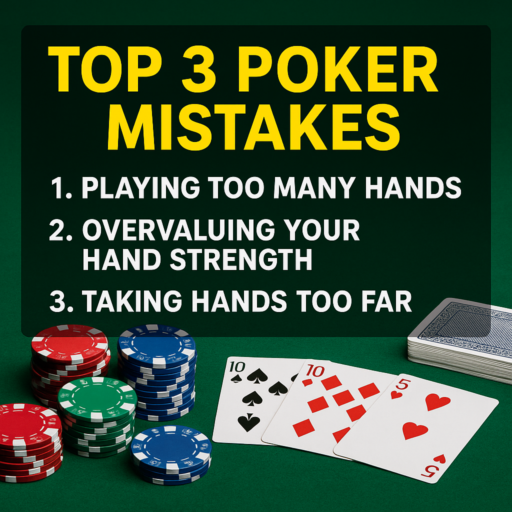
This is part of the Church of Reason series—where we don’t chase poker fads or gimmicks. We uncover truth. If you’ve ever found yourself thinking, “I knew better, but I did it anyway,” then this article will show you not just what went wrong—but why it keeps happening.
sidebar - poker in the wild: the $1/$3 game that never folds
If you’ve ever played in a $1/$3 full-ring game, you’ve likely seen it: the same four to six players are in every single pot. No fold. There’s no fear. No pause. It’s a parade of pocket rags and pipe dreams—and somehow they always believe they’ve got a shot.
But here’s the truth: they don’t have playable cards every hand. Nobody does. What they have is a misunderstanding of the game. A refusal to fold is not a sign of strength—it’s a symptom of weakness. These are the players who:
- Play too many hands (Mistake #1)
- Overvalue top pair or weak draws (Mistake #2)
- Can’t let go when they fall behind (Mistake #3)
Watch closely. You’ll see it night after night, with the same faces making the same mistakes—because they’re not playing poker. They’re playing emotion. They’re chasing connection. And they’re often trapped in a cycle of compounding leaks.
It’s not just a tell. It’s a roadmap of what not to do.
THE BIG THREE-NOT ISOLATED, BUT INTERCONNECTED
Most players think of common poker mistakes as isolated missteps—playing too many hands, overvaluing marginal holdings, or chasing down hands they should’ve let go. But these aren’t separate problems. They’re symptoms of the same deeper flaws—emotional, cognitive, and strategic weaknesses that feed off each other and often show up together in a single hand.
PLAYING TOO MANY HANDS
This is often driven by boredom, impatience, or an inflated sense of one’s ability to outplay opponents post-flop. Sometimes it’s pure fear of missing out—a compulsion to be involved, to chase action. But when these players are also multitasking, distracted by social chatter, or seated at tables they shouldn’t be in to begin with, the mistake compounds. They’re entering pots bloated with volatility and risk—without the patience or precision needed to navigate them. That leads to fatigue, frustration, and eventually, spirals out of control.
OVERVALUING HANDS
Closely linked is overvaluing hands—a common poker mistake rooted more in ego than in math. Players convince themselves that top pair is always good, or that “suited” somehow means “strong.” They overplay hands like Ace-Jack offsuit or middle pocket pairs, ignoring domination, hand equity, and basic odds. This misjudgment often comes from a romanticized view of poker, where feel and gut override math and discipline. Once ego enters the equation, it’s difficult to extract yourself from marginal spots—especially when your table image becomes that of a predictable overplayer.
PLAYING HANDS TOO FAR
Then comes the third—and often the most costly—mistake: playing hands too far. This is where emotion really takes over. A player hits middle pair and suddenly feels “invested.” They tell themselves a turn card might save them or that folding would be weak. Sunk cost fallacy creeps in, clouding judgment. Add in the fear of being bluffed or the stubbornness not to “back down,” and it’s a recipe for disaster. Good players lose more here than anywhere else—not because they didn’t know better, but because they ignored what they knew.
And here’s the critical insight: the same forces that get you into trouble pre-flop are the ones that keep you trapped post-flop. Impatience leads to loose opens, ego leads to poor value assessments, and fear leads to overcommitment. One mistake rarely walks alone. They arrive in clusters, compounding each other like interest—until the account is empty and the lesson is finally learned.
THE COMPOUNDING COGNITIVE SPIRAL-WHY ONE COMMON POKER MISTAKE LEADS TO ANOTHER
One of the most dangerous traps in poker isn’t just making a single bad decision—it’s the cascade that often follows. In most low-stakes cash games, especially full-ring formats like $1/$3 or $2/$5 no-limit hold’em, you’ll often see four to six players in every pot. And it’s almost always the same players. They don’t fold preflop, they overplay mediocre hands, and they rarely let go—even when the warning signs are all around them. These players aren’t just making mistakes. They’re stuck inside what we’ll call The Compounding Cognitive Spiral—a feedback loop of flawed thinking, emotional impulse, and undisciplined play. And once you’re in it, it’s hard to get out.

The Spiral doesn’t start on the turn or river. It begins before the cards are ever dealt. Players enter the game already carrying emotional baggage—boredom, ego, insecurity, or a desire to prove something. They play too many hands out of impatience or Fear Of Missing Out. They overvalue hands like top pair or suited connectors because they “look good” or because they’ve seen them win in highlight reels. And once they commit chips to the pot, they can’t let go—driven by hope, sunk cost, or the unwillingness to fold the “winning hand.” These three foundational mistakes—playing too many hands, overvaluing hands, and playing hands too far—aren’t isolated events. They are deeply interconnected, each one feeding the others. A player who exhibits one often exhibits all three. That’s the nature of the Spiral.
COMPOUNDING BIAS REINFORCEMENT
Psychologically, this pattern of behavior stems from a well-known dynamic in cognitive science: compounding bias reinforcement. When we make an emotionally driven decision and it fails, we don’t always correct it. More often, we double down. We reinforce the belief, blame external variables (the river card, the “lucky fish,” the rake), and preserve the ego. This reinforcement makes the next flawed decision more likely. The longer the pattern persists, the harder it is to detect—and the more damaging it becomes to both bankroll and mindset.
And that’s when the deeper issue emerges—one that transcends poker and touches on how people think. As Robert Pirsig outlined in Zen and the Art of Motorcycle Maintenance, people approach life—and poker—in one of two ways: Classically or Romantically.
THE CLASSICAL PLAYER
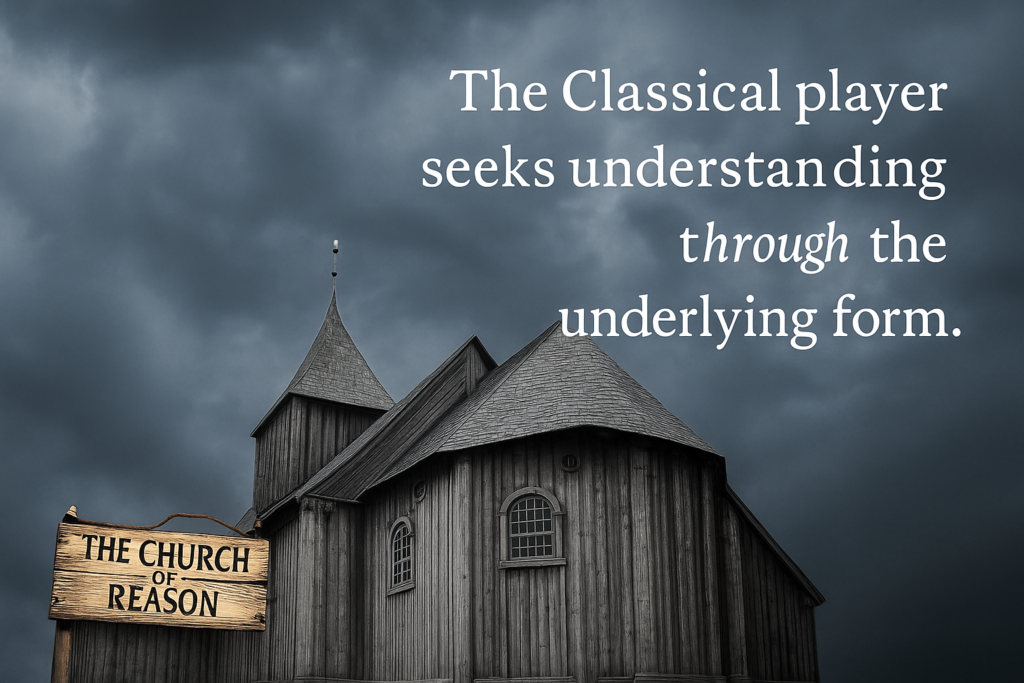
The Classical player seeks understanding through the underlying form. They want to know why things work. Classical players study probability, examine frequencies, and understand pot odds not just as a tool, but as a lens for decision-making. They don’t chase outcomes—they build frameworks. They’re patient because they understand variance, and disciplined because they respect the structure of the game.
THE ROMANTIC PLAYER
The Romantic player, by contrast, is moved by appearances and experiences. They don’t want to hear about math—they want to “feel the game.” They chase stories, not statistics. They’re seduced by suitedness, dazzled by draws, and enamored with the idea of being unpredictable. But in their pursuit of the exciting or the heroic, they overlook the structural foundation of the game. As Pirsig puts it, the Romantic avoids form because they find it boring, tedious, or limiting. But in doing so, they fall victim to chaos—both in life and at the table.
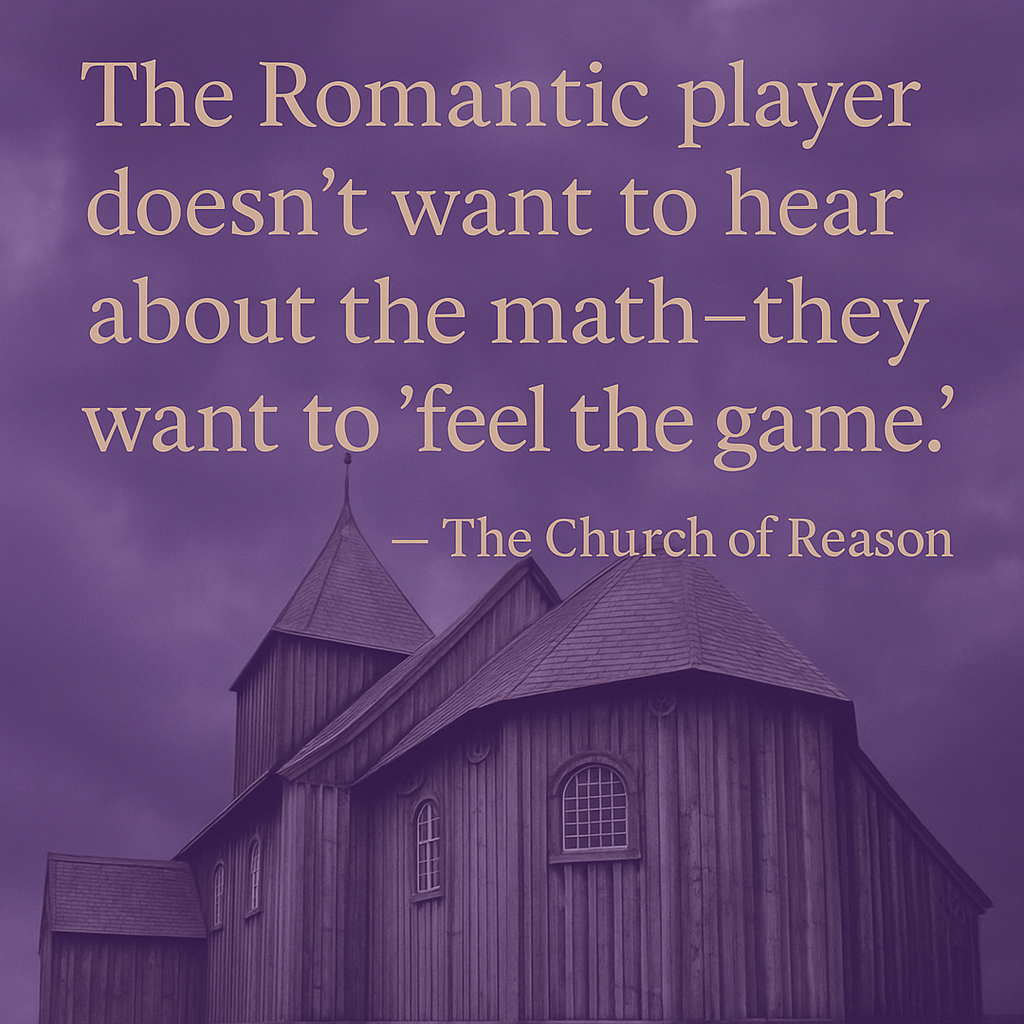
The Compounding Cognitive Spiral is, at its core, a Romantic phenomenon. It resists discipline, denies structure, and thrives in emotional decision-making. The player within the Spiral doesn’t want to fold 87 suited under the gun because it “might hit.” They don’t want to let go of top pair because they “deserve” to win. They’re not trying to make the optimal play—they’re trying to validate a narrative. That’s not poker—that’s storytelling with chips.
To escape the Spiral, a player must confront the uncomfortable truth: Poker is a game of mathematics, structure, and probability—not hope, ego, or momentum. The Classical mindset doesn’t guarantee success, but it provides a framework for improvement. It exposes the flaws, builds the foundation, and protects the player from the very human tendency to create meaning where there is none. Until a player adopts this mindset—or at least learns to recognize the Spiral when it starts—they will continue making the same mistakes, session after session, blaming everything but the truth: the problem isn’t the cards. It’s the cognition.
THE REAL DRIVERS: WHAT'S BEHIND THESE LEAKS?

If the Big Three represent the most common poker mistakes made at the table, then this section examines the engine underneath—the core behavioral and psychological forces that drive them. These aren’t simply bad habits. They are embedded traits, often reinforced by personal history, cognitive blind spots, emotional tendencies, and even the social dynamics of poker environments. Left unchecked, these drivers become the taproots of self-destruction.
BOREDOM
MULTITASKING
Boredom is one of the least discussed, yet most destructive, forces in poker. Most players arrive at the table not seeking clarity or discipline—but stimulation. They crave action. The slow nature of live games feels torturous to those who don’t understand the value of folding. For these players, folding feels like failure. They mistake stillness for weakness. But poker isn’t a game of constant motion. It’s a game of strategic waiting. And waiting, in a culture obsessed with speed and novelty, is psychologically painful. So they play hands they shouldn’t—simply because they’re tired of waiting.
Multitasking and distraction further erode a player’s judgment. Phones on the table, conversations during hands, checking sports scores—these seem harmless, but they divide cognitive bandwidth at the exact moments when clarity is most needed. Poker is a concentration game. It demands singular focus. You cannot simultaneously track betting patterns, body language, pot odds, stack depth, and range construction while arguing about fantasy football. Common poker mistakes—like misjudging pot size, misreading position, or acting out of turn—aren’t just mental errors. They’re the result of scattered attention. In a game built on thin edges, partial focus is no focus at all.
EGO
HOPE
Ego may be the most dangerous driver of all. It convinces players they are smarter than their opponents, that their reads are always right, and that folding would make them look weak. It’s ego that fuels overcommitment with marginal hands, heroic bluffs with no equity, and refusal to back down when outmatched. Ego doesn’t want to win—it wants to dominate. And in poker, domination is often punished. The truth is, ego rarely folds. And that means ego bleeds.
Hope is another subtle villain. It keeps players in hands they should abandon, whispering, “Maybe you’ll get lucky this time.” This emotional investment—the refusal to surrender because of what might happen—leads to calling down with second pair, chasing gutshots without the odds, or refusing to believe an opponent has the better hand. Hope, like ego, creates a distorted lens through which probabilities are ignored and desires are mistaken for facts.
MATH AVERSION
Then there’s math aversion—a surprisingly common trait. Many players recoil from the mathematical side of the game, as if it’s beneath them or somehow “not real poker.” They’d rather go by feel, instinct, or past experience. But this rejection of the underlying form of poker—the math that defines hand strength, pot odds, expected value, and combinatorics—ensures they are flying blind. It’s not that they can’t understand it. It’s that they choose not to. And that choice comes at a cost.
LACK OF PATIENCE
Lack of patience may be the single thread that ties all these drivers together. Patience is not passive. It is a form of discipline in motion. Without it, players cannot wait for +EV opportunities, cannot resist marginal spots, and cannot make the hard folds when intuition screams yes but reason says no. Impatience transforms leaks into patterns—and patterns into financial ruin.
MISUNDERSTANDING OF POSITION
Finally, there’s the misunderstanding of position—a fundamental concept that, when ignored, leads to nearly every common poker mistake. Players who don’t grasp the power of position overvalue weak hands, call out of turn, misread board texture, and surrender initiative. They play as if every seat is equal, unaware that early position decisions are made in darkness, while late position sees the entire room. Without understanding position, you are simply guessing—and guessing has no place in high-level poker.
The drivers behind common poker mistakes aren’t random. They are predictable, repeatable, and—if unaddressed—devastating. Poker doesn’t punish ignorance as quickly as it punishes arrogance. And in this game, most leaks don’t come from bad luck. They come from within.
MINDLESSNESS - THE HIDDEN FACTOR IN COMMON POKER MISTAKES
There’s one force quietly fueling nearly all common poker mistakes, yet it rarely gets named. That force is mindlessness the absence of focused, present-moment awareness. Without mindfulness, even well-studied players fall into mechanical, habitual patterns. They call without intention and raise without purpose. They chase pots they should let go of—not because they lack knowledge, but because they lack attention.
This isn’t just about distractions like phones, TVs, or idle conversations. It’s about internal distraction—thinking about the last bad beat, hoping for the next big hand, or replaying old regrets in your head. It’s about being physically present but mentally elsewhere. You’ve seen it: the player who stares at the board but doesn’t see it. The one who talks through every hand but never really listens. The one who folds, calls, or bets like they’re on autopilot. That’s mindlessness in action.
MINDFULNESS IS THE COUNTERWEIGHT
Mindfulness is the counterweight. This is the practice of being fully aware of what’s happening—within you and around you—without immediate judgment or reaction. It’s noticing that you’re tilted before you act on it. It’s feeling the urge to call but pausing to ask, “Why?” It’s taking in board texture, bet sizing, position, and timing before clicking into your usual routine.
When mindfulness is absent, small mistakes compound. When it’s present, space opens up between thought and action. That space is where better decisions live.
No matter how much strategy you’ve studied or how many hours you’ve logged at the table, if you’re not practicing mindfulness, you’re likely repeating the same leaks again and again. Fixing the visible mistakes—like playing too many hands or chasing with second pair—requires recognizing the invisible one that keeps them alive: not paying attention in the first place.
THE COMPOUNDING EFFECT-WHEN ONE MISTAKE LEADS TO ANOTHER
One of the most dangerous things about common poker mistakes is that they rarely exist in isolation. In fact, they tend to trigger a domino effect—where one misstep fuels another, and that second one feeds a third, until the entire session spirals into a blur of emotional decisions, inconsistent logic, and evaporated bankroll. This is the compounding effect at work, and if you’ve ever sat through a long losing night wondering how things unraveled so fast, you’ve likely been caught in its grip.
It starts subtly. A loose pre-flop call, made out of boredom or overconfidence, sets the foundation. Once you’re in the hand, ego or attachment kicks in—suddenly that top pair or weak draw feels worth defending. By the turn, your stack is already entangled, and folding feels like defeat. You chase, justify, and overcommit—not because the math supports it, but because you’re trying to make a bad decision right itself. You’re not playing poker anymore. You’re playing damage control.
COMMON POKER MISTAKE: ALLOWING BAD DECISIONS TO ERODE YOUR ABILITY TO THINK CLEARLY
Each of these decisions—playing too many hands, overvaluing mediocre holdings, refusing to let go—does more than just cost chips. It erodes your ability to think clearly. Your image at the table shifts. You begin to second-guess. Tilt creeps in, slowly at first, then with full force. What started as a minor lapse in discipline becomes a full-blown pattern of self-sabotage. This is how common poker mistakes transform into session-defining leaks.
And it doesn’t end with the hand. The compounding effect reaches beyond the table. It impacts your confidence, your focus, your mood. You leave the game carrying regret and frustration, and that baggage follows you into the next session, where the spiral threatens to start again. This is why self-awareness and strategic grounding are essential—not just for making good decisions, but for breaking the feedback loop of poor ones.
KEY TAKEAWAY
In poker, mistakes compound faster than profits. The only thing that stops the spiral is awareness, patience, and a commitment to re-centering yourself in sound fundamentals. Fix one mistake, and you often prevent five more from forming. Let one go unchecked, and the whole foundation starts to crack.
THE PSYCHOLOGY OF SELF-SABOTAGE-WHY WE KNOW BETTER, BUT STILL DO WORSE
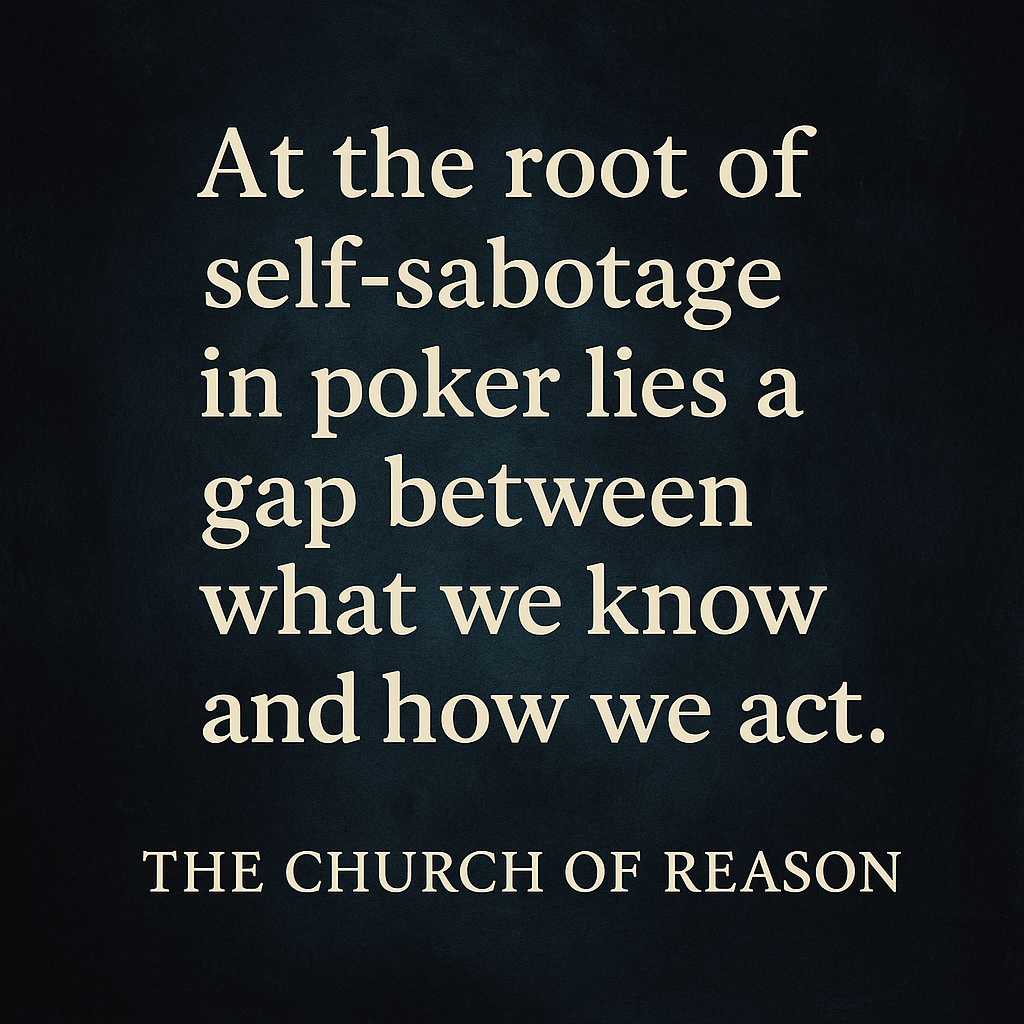
Most players don’t mean to play badly. They don’t sit down and consciously plan to call a pot-sized bet with a weak draw, or limp into a bloated pot out of position with garbage. Yet it happens—repeatedly. The reason isn’t ignorance. It’s internal conflict.
At the root of self-sabotage in poker lies a gap between what we know and how we act. We can understand pot odds, know we’re out of position, recognize that our hand is weak—but still click “call.” Why?
Sometimes, it’s emotional override. Fear of being bluffed. Hope of hitting the miracle card. The need to prove something—to others or to ourselves. Other times, it’s a deeper fracture in how we frame the game itself. This is where psychology and philosophy collide.
Many players walk into a poker room with the wrong lens. They see the game romantically, through instinct, emotion, ego, and personal narrative. They think, “I’m due”, or “This hand feels right”, or “I can’t fold another one.” And they make decisions driven not by the structure of the game, but by a story they’re telling themselves. It’s a seductive story—but it’s also a trap.
This is where we introduce a critical concept that will echo throughout the rest of this article—and your poker life:
THE CHURCH OF REASON
The Church of Reason isn’t a religion—it’s a framework. It’s the commitment to understand things by their underlying form, rather than their surface appearance. In poker, the “form” is math, position, probability, process. When you abandon form for feeling—when you let the noise of your emotions override the clarity of the structure—you invite chaos.
Most common poker mistakes stem from this deviation. The refusal to fold. The tendency to chase. The compulsion to “play back.” These aren’t just strategic errors—they’re existential ones. They reflect a rejection of Reason in favor of Rationalization.
And just like in life, when Reason is dismissed or neglected in poker, what follows is always the same: confusion, frustration, and decline.
“The worst hands I’ve ever played were the ones I justified the most.”
In the sections ahead, we’ll dive deeper into this rift—between classical logic and romantic impulse, between process and passion—and show how every leak is connected to the choice of lens through which you see the game.
THE ROMANTIC VS CLASSICAL POKER MINDSET
Every player brings a worldview to the table. Most don’t realize it, but it governs everything they do—from the hands they choose to play, to how they interpret risk, to how they respond to adversity. These worldviews, though often unnamed, fall into two broad categories: the romantic and the classical.
THE ROMANTIC PLAYER: DRIVEN BY FEELING, IMAGE & NATTATIVE
THE CLASSICAL PLAYERS: ROOTED IN STRUCTURE, FORM & PROCESS
Romantic players see poker as an emotional journey—a story in which they are the hero. Their decisions are often shaped by how they feel in the moment, or how a hand fits into their internal storyline. They may chase losses with the belief that they’re “due,” or hero-call because they “just know” they’re right. To them, poker is an experience, not a discipline.
Common traits:
- Plays to express themselves rather than exploit the game
- Hates folding, especially when it feels “weak”
- Loves flashy plays, big bluffs, and drama
- Seeks redemption in the very hands that cost them earlier
- Frames luck and variance as personal forces, rather than mathematical realities
Romantic players are often intelligent, intuitive, and passionate—but their lack of discipline leads to chaos. Their strategies crumble under pressure, and they tend to ignore the foundational truths of the game when emotion flares. They may win spectacularly, but they lose predictably.
Classical players see poker through a lens of underlying systems. To them, every action must be grounded in logic, mathematics, and strategic purpose. They don’t chase a “feel,” they run the numbers. They don’t worry about what a play looks like, they care about what it accomplishes.
Common traits:
- Views poker as a problem-solving exercise
- Values fold equity, pot odds, and positional advantage
- Rarely deviates from sound preflop ranges without purpose
- Accepts short-term losses in pursuit of long-term edge
- Recognizes the role of variance without personalizing it
Classical players don’t tilt as easily. Their discipline insulates them from the chaos that consumes others. Their progress may look less dramatic, but it’s also far more sustainable. They climb the ranks not by chasing wins—but by minimizing mistakes.
PLAYING THE WRONG GAME - A COMMON POKER MISTAKE
Most poker mistakes don’t stem from poor luck or bad cards—they stem from playing the wrong game. If you’re approaching poker romantically, you’re constantly at war with the game’s structure. You’re trying to bend math to your will, rather than letting math inform your actions.
In contrast, the classical approach aligns you with the truth of the game. You stop making decisions based on how you feel, and start making them based on how the game works. And once you do that, everything begins to shift—your win rate, your mindset, your understanding of the game itself.
“If you’re losing consistently, it’s not the cards—it’s the lens.”
Next, we’ll bring this full circle as we explore how these mindsets affect your ability to correct course, plug leaks, and ultimately thrive at the table.
THE CHURCH OF REASON-THE UNDERLYING FORM OF POKER
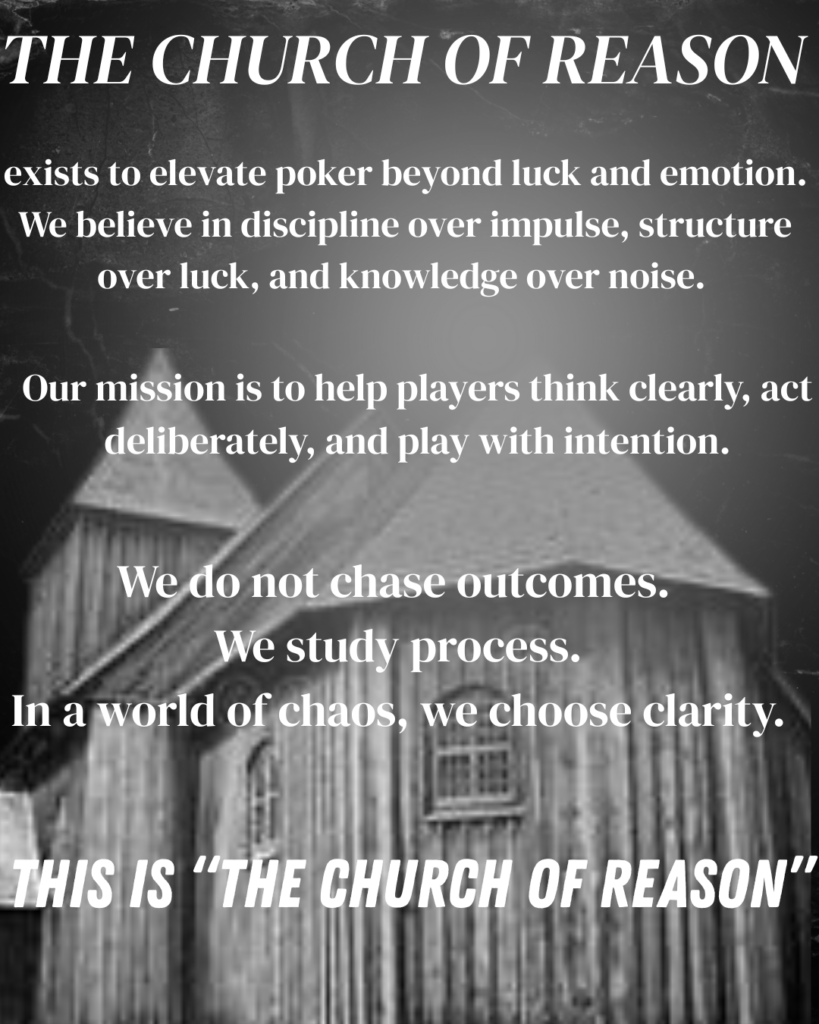
Earlier, we touched on how the romantic and classical mindsets influence a player’s ability to break out of destructive patterns. Some players chase hope and intuition. Others seek structure and truth. But to truly understand these tendencies—and correct them—we must look deeper.
At the heart of poker lies a paradox. It’s a game of emotion, deception, and psychology. But beneath all of that, it’s also a game of structure, logic, and mathematical form. The tension between these layers is where most players lose their way.
Enter the Church of Reason—a concept inspired by Robert Pirsig’s Zen and the Art of Motorcycle Maintenance. In that book, Pirsig divides people into two philosophical camps:
- Romantic thinkers, who focus on appearance, feeling, and intuition.
- Classical thinkers, who seek to understand the inner workings, the structure, the process.
Poker is a mirror of this exact dichotomy. Romantic players fall in love with suited connectors, bluff catches, or hero calls. They’re seduced by the drama of the moment. Classical players, by contrast, search for equity, pot odds, and long-term EV. They are less concerned with whether a play feels right and more with whether it is right.
Both mindsets exist in every player—but one usually dominates. And unless a player consciously balances the two, the romantic lens will almost always win out. That’s because it’s easier, more exciting, and often reinforced by selective memory (“I once hit that straight!”).
But poker doesn’t reward beauty. It rewards correct decisions.
And that means grounding yourself in the underlying form of poker—the math, the logic, the structure. It means joining the Church of Reason.
CORRECTING COURSE: HOW TO BREAK THE CYCLE
Recognizing your mistakes is only the first step. Breaking free from the compounding cycle of bad habits requires deliberate action, structured thinking, and a mindset rooted in humility and growth. This is not about “fixing your game overnight.” It’s about rewiring how you approach poker—mentally, emotionally, and strategically.
SLOW DOWN THE GAME
START WITH SUBTRACTION: NOT ADDITION
Poker mistakes often stem from impulsive, reflexive decisions. To reverse the cycle, you must interrupt that automatic behavior.
- Take the full clock: Whether online or live, get comfortable using time to think—even when it feels unnecessary.
- Practice one decision at a time: Don’t let momentum carry you through a hand. Each street deserves separate, conscious analysis.
- Breathe and reset: Especially after a big hand—win or lose—take a breath before the next one. Reset your emotional baseline.
Improvement starts not by adding new plays—but by removing the ones that hurt you.
- Fold more, especially hands that fall outside your positional or strategic range.
- Eliminate autopilot play. If you’re not focused, you’re just donating.
- Avoid default limping—but don’t dismiss strategic limping. In some live games, particularly those with splashy players and multiway action, limping can be mathematically correct and deceptively powerful. Know when you’re doing it—and why.
Subtraction simplifies. And simplification brings clarity.
REBUILD WITH CORE POKER CONCEPTS
TRACK PATTERNS: NOT JUST RESULTS
Once you stop the bleeding, it’s time to reconstruct your game around durable, foundational skills. These are the bedrock of winning play:
- Position: Make every decision with positional leverage.
- Pot Odds & Hand Equity: Understand the math. Let it guide—not override—your judgment.
- Ranges: Think beyond your cards. What does your opponent’s range say?
- Patience: Let the game come to you. Don’t force action just to feel involved.
- Mindfulness: Be present. Every hand has something to teach you—if you’re awake to it.
Winning isn’t about trick plays. It’s about strong, disciplined repetition of correct fundamentals.
Most players only review outcomes. But poker isn’t a game of outcomes—it’s a game of decisions.
- Measure success by process: Did you make the best decision possible with the information available? That’s what matters—not the river card.
- Record hands: Note what went right or wrong—stack sizes, table image, betting lines, reads, tells, etc.
- Own your demeanor: Poker mastery means your emotional state is invisible. Whether you’re ecstatic or gutted, your table presence stays neutral. No outbursts, no tells, no reactions. Just quiet, contained intensity.
Your edge isn’t just what you know. It’s how you apply it—calmly, consistently, and without giving anything away.
.
SHIFT FROM IDENTITY TO PROCESS
You are not a “bad player” because you made a mistake. You are a learning player correcting your process.
- Detach from results: One bad session doesn’t define you.
- Adopt a scientific mindset: Every hand is data. Use it.
- Replace ego with curiosity: Instead of trying to prove something, focus on discovering what the hand is trying to teach you.
ALWAYS THINK "AT LEAST" ONE STREET AHEAD
Poker isn’t a game of isolated actions—it’s a game of sequences. Each decision should connect to the next.
- Don’t just ask “What should I do now?” Ask: “What happens if I get called?” “What’s my plan on the turn?” “Am I setting up a river shove—or a fold?”
- Strong players plan ahead, weak players react. If you’re always asking “now what?” after each street, you’re already behind.
- Learn to play in decision trees, not single branches. Think through the lines before you fire the first bet.
The more levels you think through—and the fewer your opponents do—the more control you gain over the outcome.
FINAL THOUGHTS: POKER TOOLS NOT RULES
Poker is not a game of rigid systems. It’s a game of evolving decisions—made in real time, under pressure, against imperfect information. If you’re looking for a set of unbreakable commandments, you’re in the wrong arena. But if you’re looking for a mental toolkit—one built on math, observation, psychology, discipline, and foresight—then you’re exactly where you need to be.
The common poker mistakes we’ve explored—playing too many hands, overvaluing hands, playing them too far—aren’t just errors in strategy. They’re signals. Signals that something deeper is misaligned: your mindset, your focus, your understanding of the game’s underlying form.
We’ve shown how these leaks don’t exist in isolation. They spiral together. They reinforce each other. And they’re often driven not by ignorance, but by impatience, ego, distraction, fear, or a romanticized view of how poker should feel, rather than how it works.
The solution? Start by adopting the classical lens. Ground yourself in structure. Prioritize decisions over emotions. Study the math not to memorize it, but to understand it. Become mindful at the table. Focus your energy not on what just happened, but on what happens next. Don’t play a hand—play the situation. Don’t play your cards—play your opponents. Do not chase outcomes—pursue quality decisions.
And most of all: stop looking for poker rules.
Instead, sharpen your tools.




